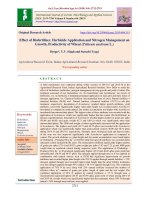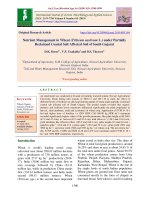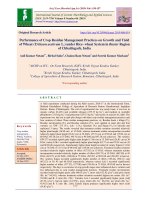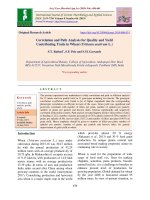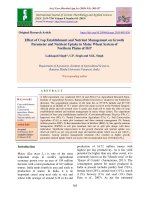Effect of biofertilizer, herbicide application and nitrogen management on growth, productivity of wheat (Triticum aestivum L.)
Bạn đang xem bản rút gọn của tài liệu. Xem và tải ngay bản đầy đủ của tài liệu tại đây (216.16 KB, 8 trang )
Int.J.Curr.Microbiol.App.Sci (2019) 8(4): 2712-2719
International Journal of Current Microbiology and Applied Sciences
ISSN: 2319-7706 Volume 8 Number 04 (2019)
Journal homepage:
Original Research Article
/>
Effect of Biofertilizer, Herbicide Application and Nitrogen Management on
Growth, Productivity of Wheat (Triticum aestivum L.)
Deepa*, Y.V. Singh and Suruchi Tyagi
Agricultural Research Farm, Indian Agricultural Research Institute, New Delhi 110012, India
*Corresponding author
ABSTRACT
Keywords
Biofertilizer,
Herbicide,
Application,
Nitrogen,
Management,
Wheat,
Triticum aestivum
Article Info
Accepted:
20 March 2019
Available Online:
10 April 2019
Introduction
A field experiments was conducted during winter seasons of 2014-15 and 2015-16 at the
Agricultural Research Farm, Indian Agricultural Research Institute, New Delhi to study the
effect of biofertlizer, herbicides, nitrogen management on crop growth and yield of wheat. The
treatment consisted of two biofertilizer viz. No biofertilizer and Azotobacter, two levels of
herbicides, viz. no herbicide, Clodinafop-propargyl application in main plot and three times of
nitrogen application, viz. Chemical fertilizer (recommended dose of urea), Natural fertilizer +
chemical fertilizer (50:50) and Natural fertilizer +chemical fertilizer (25:75) in sub plot
treatment, respectively. Inoculation of Azotobacter resulted higher growth attributes, yield
attributes, seed yield. Significantly higher value plant height was recorded under Azotobacter
inoculated as compared to uninoculated. Dry matter accumulation was higher with Azotobacter
inoculated than uninoculated plants. The highest value of these attributes was recorded with the
application of Azotobacter which was significantly higher that the control (No biofertilizer) in
present experimentation. Inoculation of Azotobacter resulted higher number of grains per spike
(58.06 and 60.85) and grain weight (6.71 and 6.89 g) which was significantly more than
uninoculated plants. The 1000 seed weight of wheat significantly increased with the application
of Azotobacter. The highest seed yield (45.77 and 46.72 q/ha) was recorded with Azotobacter
application which was significantly higher than uninoculated control (38.98 and 46.72 q/ha)
during 2014-15 and 2015-16, respectively. Similarly straw, biological yield and harvest index
of the crop was also improved significantly with Azotobacter application as compared to
control. The growth attributes i.e. plant height and dry matter accumulation were found higher
in Clodinafop – Propargyl 60 g ha-1 at 30 DAS while least growth attributes was recorded under
untreated control during both the years. The treated plots exhibited significantly higher number
of grains per spike (57.14 and 59.87), grain weight per spike (7.05 and 7.23 g) and 1000-grain
weight than no weedicide control during respective years. The application of Clodinafop –
Propargyl 60 g ha-1 at 30 produced significantly higher (45.15 and 46.62 q/ha) grain yield than
untreated plots (36.59 and 40.57 q/ha). The nitrogen applied through urea or it was applied in
combination with natural sources such as FYM had significant improvement on growth
attributes and recorded higher plant height with 25% N applied through natural fertilizer + 75%
nitrogen applied through urea recorded higher plant height than the other fertility treatments
over the nitrogen applied through 50% natural + 50 % N applied through Urea. The combined
application of 75% N by urea along with 25% natural fertilizer increased the number of
effective tillers m-2, number of grains per spike, length of spike and the test weight. The
combined application of 25% N applied by natural fertilizers + 75 N through urea +
micronutrients registered highest (44.47 and 45.94 q/ha) grain yield of wheat during 2014-15
and 2015-16 of study which was significantly higher than the treatments where 50% N through
natural + 50% through urea fertilizers were applied.
2712
Int.J.Curr.Microbiol.App.Sci (2019) 8(4): 2712-2719
Wheat is the most important cereal crop
which is badly infested with grassy as well as
broad-leaf weeds. Since 1982 isoproturon is
most widely used herbicide for management
of Phalaris minor in wheat, particularly under
rice-wheat cropping system. But, its efficacy
has declined due to development of resistance
in P. minor. However, the sole dependence on
herbicide of single mode of action is also not
advisable as it has contributed to shift towards
difficult to control weeds and rapid evolution
of multiple herbicides resistance, which is a
threat to wheat production (Singh 2007).
Therefore, there is need to use mixture of
herbicides in a way to lower the load on
environment and improve weed control
efficacy without any adverse effect on crop.
Nitrogen (N) is the nutrient that most often
limits crop production. Among major cereals,
wheat requires 1 kg of N to produce 44 kg of
wheat (Pathak et al., 2003). Generally, more
than 50% of the N applied is not assimilated
by plants. Significant interaction between
herbicide and nitrogen, where increased
nitrogen found to enhance the performance of
herbicide as well as N-scheduling not only
influences the crop growth but also influences
weed density and biomass also (Kim et al.,
(2006). However, information in this regard is
lacking. So, there is a greater need for new
formulated herbicides with nitrogen rates and
time of application to make out the effect of
treatments on growth and yield of wheat.
split plot design with three replications. The
soil of the experimental field was sandy-loam
in texture, low in organic carbon (0.542%),
available nitrogen (159.90 kg/ha) and
available phosphorus (10.63 kg/ha) contents
while was medium in available potassium
(168.73 kg/ha).
The soil reaction was near neutrality with
slight alkaline tendency. The treatment
consisted of two biofertilizer viz. No
biofertilizer and Azotobacter, two levels of
herbicides, viz. no herbicide, Clodinafoppropargyl application in main plot and three
times of nitrogen application, viz. Chemical
fertilizer (recommended dose of urea),
Natural fertilizer + chemical fertilizer (50:50)
and Natural fertilizer +chemical fertilizer
(25:75) in sub plot treatment, respectively.
Wheat variety ‘HD-2967’ was sown on 21
November, 2014 and 20 November, 2015
with 125 kg seed/ha by keeping row to row
spacing of 22.5 cm during both the years of
investigations, respectively.
The wheat seed used for sowing the plots
receiving
biofertilizer
treatment
was
inoculated with Azotobacter obtained from
the Division of Microbiology, IARI, New
Delhi. Nitrogen applied as per treatment but
full amount of P and K were applied at the
time of sowing. Herbicides were dissolved in
600 liters water and applied at 30 days after
sowing (DAS), using the knapsack sprayer
fitted with flat fan nozzle.
Materials and Methods
The Field experiment was conducted on a
field site during Rabi seasons for two
consecutive years of 2014-15 and 2015-16 at
the Agricultural Research Farm, Indian
Agricultural Research Institute, New Delhi
110012, (28°38’N, 77°11E, 228.6 m above
sea level) to study the Effect of nitrogen
management and herbicide (Clodinafoppropargyl) on growth and yield of wheat in
Observations were recorded on growth, yield
attributes and grain and straw yield as per
standard procedure. Grain yield recorded in
kg/plot was finally converted into grain yield
kg/ha. All data were put to analysis of
variance as described by Gomez and Gomez
(1984). The mean assessment was
accomplished by least significant difference
(LSD) at 5% level of probability.
2713
Int.J.Curr.Microbiol.App.Sci (2019) 8(4): 2712-2719
Results and Discussion
Effect on plant growth
The application of Azotobacter brought about
significant improvement in term of plant
height and dry matter accumulation in both
years of experimentation. Significantly higher
value plant height was recorded under
Azotobacter inoculated as compared to
uninoculated. Dry matter accumulation was
higher with Azotobacter inoculated than
uninoculated plants. It may also be noted that
not only accumulation of dry matter was
increased due to the effects of Azotobacter
application, but translocation of dry matter as
well as its efficiency were also found to be
higher in crop plants applied Azotobacter as
compared to control. Thus, improvement in
plant height, dry matter accumulation is
sufficient to indicate that dry matter
partitioning was favorably influenced by
Azotobacter
application.
The
growth
attributes i.e. plant height and dry matter
accumulation were found higher in
Clodinafop – Propargyl 60 g ha-1 at 30 DAS
while least growth attributes was recorded
under untreated control during both the years.
Plant height and dry matter accumulation in
wheat crop were significantly higher in
treated with Clodinafop – Propargyl 60 g ha-1
at as compared to that of untreated during
both the years. The application of nitrogen
through natural sources and chemical sources
i.e. urea either in isolation or in combination
had significant effect on the growth of wheat
crop (Table 1). The nitrogen applied through
urea or it was applied in combination with
natural sources such as FYM had significant
improvement on growth attributes and
recorded higher plant height with 25% N
applied through natural fertilizer + 75%
nitrogen applied through urea recorded higher
plant height than the other fertility treatments
over the nitrogen applied through 50% natural
+ 50 % N applied through Urea. This might
have resulted from the higher availability of
nutrients and also the better growing
conditions in the root zone created by the
organic manures applied to the wheat crop.
The higher plant height recorded in treatment
receiving combined application 75% N by
Urea + 25% by natural fertilizer had
favourable impact on the dry matter
accumulation by wheat and resulted in higher
dry matter accumulation at all observational
stages than the treatments receiving only N by
urea or 50% by Urea + 50% by natural
fertilizers. The higher dry weight of wheat
could have been achieved through production
of more number of tillers owing to the
availability of all the nutrients especially
nitrogen. The beneficial effect of N through
fertilizers on growth of wheat had been
reported earlier by many workers i.e. Singh et
al., (2011) and Tejalben et al., (2017).
Effect on yield and yield attributes
The application of Azotobacter brought
significant improvements in yield attributes
like spike length, spike weight, number of
grains per spike, seed weight per plant and
1000 seed weight. The highest value of these
attributes was recorded with the application of
Azotobacter which was significantly higher
that the control (No biofertilizer) in present
experimentation. Inoculation of Azotobacter
resulted higher number of grains per spike
(58.06 and 60.85) and grain weight (6.71 and
6.89 g) which was significantly more than
uninoculated plants. The 1000 seed weight of
wheat significantly increased with the
application of Azotobacter. The lowest 1000
seed weight was recorded in control. Since
seed size and protein content of particular
genotypes
are
genetically-controlled
characters, therefore such traits cannot be
manipulated when the crop is grown under
relatively high input condition. However,
under control condition, reduction in seed size
and protein content from the potential value
2714
Int.J.Curr.Microbiol.App.Sci (2019) 8(4): 2712-2719
of any particular genotype can be offset by
biofertilizer application, which is very cost
effective and is unique N-source that enters
the plant system very quickly and effectively.
Barik and Goswami, (2003) reported that use
of 75% RDN (100 kg N ha-1 RDH) along with
Azotobacter seed inoculation showed at par
results of yield attributes (effective tillers/m2,
ear length and grains per ear) and yield.
The seed, straw and biological yield of wheat
enhanced significantly with the application of
Azotobacter. The highest seed yield (45.77
and 46.72 q/ha) was recorded with
Azotobacter
application
which
was
significantly higher than uninoculated control
(38.98 and 46.72 q/ha) during 2014-15 and
2015-16, respectively. Similarly straw,
biological yield and harvest index of the crop
was also improved significantly with
Azotobacter application as compared to
control. The higher value of yield attributing
characters and finally yield of wheat was
found due to application of Azotobacter
indicating the synergistic effect of the micro
organisms. Similar results confirm by Gawali
et al., (2018).
The application of post emergence of
Clodinafop – Propargyl 60 g ha-1 at 30 DAS
recorded significantly higher number of
spikes m-2, number of grains per spike and
1000 grain weight than weedy check during
both the years. The treated plots exhibited
significantly higher number of grains per
spike (57.14 and 59.87), grain weight per
spike (7.05 and 7.23 g) and 1000-grain weight
than no weedicide control during respective
years. Shezad et al., (2012) and Hamada et
al., (2013) confirms that the application of
post-emergence
Clodinafop-Propargyl
formulations for controlling annual grassy
weeds in wheat fields increased length of
spike (cm), weight of spike (g), weight of
1000 grain (g), number of spikelet spike−1,
number of grains spike−1 and wheat grain and
straw yields (kg plot−1). Wheat yield was
affected remarkably by the weeds as in the
present investigation. Uncontrolled weeds on
an average caused 12.31 and 12.61 per cent
reduction in the yield during 2014-15 and
2015-16, respectively as compared to post
emergence application of clodinafoppropargyl. The reduction of wheat yield due
to weed infestation amounted 30.7% to 61%
compared to weed-free control. Fenoxaprop
and clodinafop-propargyl were most effective
in controlling Phalaris minor and A. fatua
with maximum mortality of 86.76 and
85.52%, respectively. The application of
Clodinafop – Propargyl 60 g ha-1 at 30
produced significantly higher grain yield than
untreated plots. Bharat and Karchroo (2007)
also reported superiority of tank mixing of
clodinafop + metsulfuron methyl over
isoproturon alone in broadening the spectrum
of weed control and increasing yield. Malik et
al., (2013) found clodinafop 0.06 kg/ha very
effective (95-98%) only against grassy weeds.
clodinafop- propargyl + metsulfuron- methyl
being at par with clodinafop fb metsulfuron
0.06 and 0.004 kg/ha recorded the number of
spikes, 1000-grain weight and grain yield of
wheat statistically similar to that of weed free
check.
The combined application of 75% N by urea
along with 25% natural fertilizer increased the
number of effective tillers m-2, number of
grains per spike, length of spike and the test
weight. The enhanced early vegetative growth
in terms of higher dry matter accumulation
and vigorous root system resulted in more
number of tillers m-2 which consequently
increased the number of ear bearing tillers
significantly. The combined application of
75% N by urea along with 25% natural
fertilizer also increased the number of grains
per ear and test weight. However, in case of
test weight, the treatment difference lacked
significance including control (Table 2).
2715
Int.J.Curr.Microbiol.App.Sci (2019) 8(4): 2712-2719
Table.1 Plant height, dry matter accumulation and yield attributes as influenced by biofertilizer, weed control and nitrogen
management
Treatments
Plant height
(cm)
Dry matter
accumulation
(g/plant)
Effective tillers
(m2)
Spike length (cm)
Spike weight (g)
2014-15
2015-16
2014-15
2015-16
2014-15
2015-16
2014-15
2015-16
2014-15
2015-16
No biofertilizer
96.82
98.35
1572.23
1590.83
358.27
363.51
9.67
9.07
2.77
2.98
Azotobacter application
102.40
103.51
1652.75
1688.58
364.75
373.40
10.52
10.60
3.12
3.29
S.Em. (±)
0.53
0.70
3.39
5.19
0.57
0.61
0.05
0.06
0.02
0.02
CD at 5%
1.82
2.41
11.71
17.92
1.97
2.55
0.16
0.17
0.06
0.07
No weedicide
98.24
99.57
1590.72
1606.09
355.31
359.40
9.94
9.53
2.81
3.06
Clodinafop-propargyl
application
100.97
102.29
1634.25
1673.32
367.71
377.50
10.25
10.15
3.08
3.21
S.Em. (±)
0.53
0.70
3.39
5.19
0.57
0.61
0.05
0.06
0.02
0.02
CD at 5%
1.82
2.41
11.71
17.92
1.97
2.55
0.16
0.17
0.06
0.07
100% though Urea
100.45
101.83
1632.63
1661.62
364.66
371.67
10.19
10.12
2.96
3.19
50% Natural fertilizer +
50% Urea
95.91
96.89
1529.29
1550.12
347.12
351.38
9.80
9.13
2.77
2.84
25% Natural fertilizer +
75% Urea
102.46
104.06
1675.54
1707.38
372.75
382.31
10.30
10.27
3.10
3.37
S.Em. (±)
1.06
0.94
7.08
7.68
1.81
2.23
0.11
0.10
0.03
0.03
CD at 5%
3.17
2.81
21.05
23.04
5.41
6.89
0.33
0.31
0.09
0.10
Biofertilizer
Weedicide application
Nitrogen management
2716
Int.J.Curr.Microbiol.App.Sci (2019) 8(4): 2712-2719
Table.2 Yield and yield attributes as influenced by biofertilizer, weed control and nitrogen management
Treatments
No of grains per 1000 seed weight Seed weight (g) Grain yield (q/ha)
spike
(g)
per plant
Straw yield (q/ha)
2014-15
2015-16
2014-15
201516
201415
201516
2014-15
2015-16
2014-15
2015-16
No biofertilizer
51.33
54.12
42.73
42.93
6.08
6.26
38.98
40.26
51.09
52.23
Azotobacter application
58.06
60.85
43.76
43.94
6.71
6.89
45.77
46.72
58.08
59.43
S.Em. (±)
0.56
0.62
0.09
0.07
0.05
0.06
0.20
0.29
0.37
0.30
CD at 5%
1.93
2.13
0.30
0.26
0.18
0.21
0.70
0.99
1.26
1.05
No weedicide
52.25
55.10
43.00
43.24
5.74
5.92
39.59
40.57
52.79
54.04
Clodinafop-propargyl
application
57.14
59.87
43.49
43.63
7.05
7.23
45.15
46.42
56.38
57.62
S.Em. (±)
0.56
0.62
0.09
0.07
0.05
0.06
0.20
0.29
0.37
0.30
CD at 5%
1.93
2.13
0.30
0.26
0.18
0.21
0.70
0.99
1.26
1.05
55.21
58.07
43.34
43.57
6.41
6.59
41.68
42.67
54.89
56.04
50% Natural fertilizer + 49.30
50% Urea
52.20
42.55
42.75
5.76
5.93
40.97
41.87
51.79
53.15
25% Natural fertilizer + 59.58
75% Urea
62.20
43.84
43.99
7.01
7.21
44.47
45.94
57.07
58.29
Biofertilizer
Weedicide application
Nitrogen management
100% though Urea
S.Em. (±)
0.80
0.80
0.09
0.08
0.06
0.08
0.47
0.45
0.53
0.58
CD at 5%
2.39
2.40
0.26
0.24
0.19
0.23
1.40
1.36
1.60
1.75
2717
Int.J.Curr.Microbiol.App.Sci (2019) 8(4): 2712-2719
Stimulated vegetative growth of wheat on
account of adequate and prolonged supply of
essential nutrients in treatments receiving
natural fertilizer and micronutrients in
addition to the 75% N through urea
manifested itself in increased number of
effective tillers m-2, number of grains per ear
and test weight. The cumulative effect of
improved growth, increased dry matter
accumulation
and
yield
contributing
characters significantly increased the grain
yield of wheat. The combined application of
25% N applied by natural fertilizers + 75 N
through urea registered highest grain yield of
wheat during both the years of study which
was significantly higher than the treatments
where 50% N through natural + 50% through
urea fertilizers were applied. The increase in
grain and straw yield of wheat might be due
to the increased availability of essential
nutrients to the crop resulting from the
cumulative effect of organic sources of
nutrient applied to wheat crop. The harvest
index of wheat also recorded a trend similar
to grain yield but the treatment differences
were short of significance. Chauhan, et al,
2011). Aleminew et al., (2015).
References
Aleminew, Amare, Adane Legas and
Mekonen Misganaw.2015. Yield
Response of Bread Wheat to Timing
of Urea Fertilizer Application in
Eastern Amhara Region. Journal of
Biology, Agriculture and Healthcare.
Vol.5, No.3, 2015.
Barik and Goswami, (2003). Efficacy of
biofertilizers with nitrogen levels on
growth, productivity and economics in
wheat (Triticum aestivum). Indian
Journal of Agronomy 48(2):100-102
Bharat and Karchroo, (2007). Effect of
different herbicides on mixed weed
flora, yield and economics of wheat
(Triticum aestivum) under irrigated
conditions of Jammu. Indian Journal
of Agricultural Sciences 77(6):383386
Chauhan, D.S., Shrama, R.K., Tripathi, S.C.
Kharub, A.S. and Chhokar,R.S. (2011)
News paradigm in tillage technology
for wheat production. Research
Bulletin NO. 8, DWR, Karnal, pp: 16
Gomez, KA and Gomez, AA., 1984.
Statistical Procedures for Agricultural
Research, (2nd Ed. 1984), John
Willey and Sons Inc. New York, USA.
Hamada,
SHE.,
Abdel-Lateef,
MF.,
Abdelmonem, AE., El-Kholy, RMA.,
Helalia, AAR. (2013). Efficiency of
certain
clodinafoppropargyl
formulations in controlling annual
grassy weeds in wheat. Annals of
Agricultural Science 58(1): 13-18.
Kim DS, Marshall EJP, Caseley JC and Brain
P. 2006. Modelling interactions
between herbicide and nitrogen
fertilizer in terms of weed response.
Weed Research 46 (6): 480–491.
Kumar, S., Angiras, N.N. and Rana, S. S.
2011. Bio-efficacy of clodinafoppropargyl
+
metsulfuron-methyl
against complex weed flora in wheat.
Indian Journal of Weed Science
43(3&4): 195-198.
Malik, R.S., Yadav, Ashok and Kumari,
Ramesh. (2013). Indian Journal of
Weed Science 45(3): 179–182, 2013
Patel Tejalben, G, Dr. Khushvadan C Patel
and Patel Vimal (2017). Effect of
integrated nutrient management on
yield attributes and yield of wheat
(Triticum aestivum L.) International
Journal of Chemical Studies 5(4):
1366-1369
Pathak, H., Aggarwal PK, Roetter R, Kalra N,
Bandyopadhaya SK, Prasad, S and
Van Keulen H. 2003. Modeling the
quantitative evaluation of soil nutrient
supply, nutrient use efficiency, and
fertilizer requirements of wheat in
2718
Int.J.Curr.Microbiol.App.Sci (2019) 8(4): 2712-2719
India.
Nutrient
Cycling
in
Agroecosystems 65: 105–113.
Gawali and Shila, R, P.K. Unni. (2018).
Integrated Nutrient
Management
Approach on Wheat (Triticum
aestivum L.) in Vertisols Int. J. Curr.
Microbiol. App.Sci. 7(4): 3144-3153
Shehzad, M.A., Muhammad Maqsood,,
Muhammad Anwar, Haq and Abid
Niaz (2012). Efficacy of various
herbicides against weeds in wheat
(Triticum aestivum L.) African
Journal of Biotechnology Vol. 11(4),
pp. 791-799
Singh, S, Punia SS, Yadav A and Hooda VS.
2011. Evaluation of carfentrazoneethyl + metsulfuron-methyl against
broad leaf weeds of wheat. Indian
Journal of Weed Science, 43(1&2):
12-22.
Singh Samunder, 2007. Role of management
practices on control of isoproturonresistant little seed canary grass
(Phalaris minor) in India. Weed
Technology 21: 339-346.
How to cite this article:
Deepa, Y.V. Singh and Suruchi Tyagi. 2019. Effect of Biofertilizer, Herbicide Application and
Nitrogen Management on Growth, Productivity of Wheat (Triticum aestivum L.).
Int.J.Curr.Microbiol.App.Sci. 8(04): 2712-2719. doi: />
2719
